Modification of Cumulus Convection and Planetary Boundary Layer Schemes in the GRAPES Global Model
LIU Kun(刘琨),CHEN Qiying(陈起英),and SUN Jian(孙健)
1 National Meteorological Center,China Meteorological Administration,Beijing 100081
2 Numerical Weather Prediction Center of China Meteorological Administration,Beijing 100081
Modification of Cumulus Convection and Planetary Boundary Layer Schemes in the GRAPES Global Model
LIU Kun1,2∗(刘琨),CHEN Qiying1,2(陈起英),and SUN Jian1,2(孙健)
1 National Meteorological Center,China Meteorological Administration,Beijing 100081
2 Numerical Weather Prediction Center of China Meteorological Administration,Beijing 100081
Cumulus convection is a key linkage between hydrological cycle and large-scale atmospheric circulation. Cumulus parameterization scheme is an important component in numerical weather and climate modeling studies.In the Global/Regional Assimilation and Prediction Enhanced System(GRAPES),turbulent mixing and diffusion approach is applied in its shallow convection scheme.This method overestimates the vertical transport of heat and moisture fluxes but underestimates cloud water mixing ratio over the region of stratocumulus clouds.As a result,the simulated low stratocumulus clouds are less than observations. To overcome this problem,a mass flux method is employed in the shallow convection scheme to replace the original one.Meanwhile,the deep convection scheme is adjusted correspondingly.This modification is similar to that in the US NCEP Global Forecast System(GFS),which uses the simplified Arakawa Schubert Scheme(SAS).The planetary boundary layer scheme(PBL)is also revised by considering the coupling between the PBL and stratocumulus clouds.With the modification of both the cumulus and PBL schemes,the GRAPES simulation of shallow convective heating rate becomes more reasonable;total amounts of stratocumulus clouds simulated over the eastern Pacific and their vertical structure are more consistent with observations;the underestimation of stratocumulus clouds simulated by original schemes is less severe with the revised schemes.Precipitation distribution in the tropics becomes more reasonable and spurious precipitation is effectively suppressed.The westward extension and northward movement of the western Pacific subtropical high simulated with the revised schemes are more consistent with Final Operational Global Analysis(FNL)than that simulated with the original schemes.The statistical scores for the global GRAPES forecast are generally improved with the revised schemes,especially for the simulation of geopotential height in the Northern Hemisphere and winds in the tropics.Root mean square errors(RMSEs)decrease in the lower and upper troposphere with the revised schemes.The above results indicate that with the revised cumulus and PBL schemes,model biases in the tropics decrease and the global GRAPES performance is greatly improved.
GRAPES model,cumulus parameterization,boundary layer diffusion,mass flux
1.Introduction
Cumulus convection is an important process that links hydrologic cycle and large-scale atmospheric circulation.Cumulus parameterization scheme is one of the most important physical schemes in numerical weather and climate models.Particularly in the tropics where cumulus convections are active,large amounts of precipitation and accompanied latent heat release play a key role in tropical atmospheric circulation and global energy balance.Large latent heat release in the tropics also exerts great impact on midhigh latitude wind fields by providing kinetic energy to these regions.Cumulus parameterization scheme is a key component and also a research focus in numerical weather and climate modeling studies.Appropriate cumulus scheme can well describe impacts of several kilometer sub-grid scale processes on large-scale cir-culation,and thus is a key issue in numerical model development.Cumulus scheme includes two types:deep convection scheme and shallow convection scheme,according to the depth of convective clouds.Shallow convection helps for the vertical diffusion of moisture and heat fluxes,while the latent heat released during shallow convection can affect the development of deep convection via re-condensation of atmospheric moisture.This process subsequently affects large-scale circulation over the entire tropics and extratropics,making great contributions to the maintenance of the thermodynamic structure of the whole atmosphere(von Salzen et al.,2005;Nie and Kuang,2012).In addition,the cloud base of shallow convection is often located at the top of the planetary boundary layer(PBL).Therefore,successful simulation of stratocumulus clouds,which is related to the PBL structure,is highly dependent on appropriate shallow convection scheme(Li and Wang,2010;Liu et al.,2010;Yang et al.,2010).
Supported by the National Natural Science Foundation of China(41305090),National Science and Technology Support Program of China(2012BAC22B02),and China Meteorological Administration Special Public Welfare Research Fund(GYHY201406005).
∗Corresponding author:kliu@cams.cma.gov.cn.
©The Chinese Meteorological Society and Springer-Verlag Berlin Heidelberg 2015
The simplified Arakawa-Schubert(SAS)cumulus parameterization scheme(Pan and Wu,1995)is currently applied in the global GRAPES.The deep convection in this scheme is a bulk convection scheme,which is based on the concept of mass flux proposed by Arakawa and Schubert(1974)but with some modification.This scheme can well describe essential physical interaction between cumulus convection and largescale circulation,especially the circulation in the tropics(Deng et al.,2008;Xu et al.,2014).
However,shallow convection scheme in the SAS still follows the method proposed by Tiedtke et al.(1988)to describe vertical transport of moisture and heat fluxes over stratifically unstable regions.This method describes the vertical transport of moisture and heat fluxes based on turbulent diffusion,which can effectively eliminate convective available potential energy(CAPE)over the areas where shallow convection occurs.While it can describe the physical processes involved in shallow convection,this method also overestimates shallow convection and large biases can be found at the top of the shallow convection.In this study,the GRAPES global model is initialized by using the Final Operational Global Analysis(FNL)analysis from NCEP and continuously runs for eight days. The results of the first two days are discarded due to the influence of initial fields.Simulated heating rate for the 3rd day of the simulation is analyzed here.The results are shown in Fig.1.Zonally average convective heating rate decreases abruptly over the tropics at around 800 hPa(Fig.1a).Comparing Fig.1a with Fig.1b,it is found that the decrease in convective heating is attributed to significant cooling at the top of the shallow convection.Over the areas where shallow convection is active,vertical profiles of convective heating rate at two single points are shown in Figs. 1c and 1d,respectively.One point is located to the east of the inter-tropical convergence zone(ITCZ)at 2°S,100°W,and the other is located inside the South Pacific convergence zone(SPCZ)at 5°S,120°E.Cold bias is found at the top of the simulated shallow convection at both points.The unrealistic simulation of shallow convection is mainly attributed to the turbulent mixing and diffusion method used in the shallow convection scheme of GRAPES,which leads to abnormal warming at low levels and cooling at upper levels.
Mass flux method has been widely employed in many numerical models to describe cumulus convection(Arakawa and Schubert,1974;Tiedtke,1989;Kain and Fritsh,1990;Zhang and McFarlane,1995;Liu and Ding,2002).The physical processes involved in deep and shallow convection are essentially the same,although the convective cloud depth is different between the two types of convection.Therefore,it is reasonable to apply the mass flux method to shallow convection simulation.
In order to overcome the problem in the simulation of convective heating rate and optimize the cumulus parameterization scheme,the turbulent mixing and diffusion method currently used in the GRAPES for shallow convection is replaced by the mass flux method.The mass flux method has been applied in the shallow convection scheme of the NCEP GFS operational model(Han and Pan,2011),which provides a good reference for the present study.In addition,some physical processes that are more realistically described in shallow convection scheme,for example,the overshooting and the convection triggering mechanismthat highly depends on the vertical velocity of the environment,are added to the deep convection scheme to keep consistency between deep and shallow convection schemes.These changes are expected to provide more reasonable simulations.

Fig.1.Zonal mean convective heating rate(K day-1)simulated by the global GRAPES using original convective scheme.(a)Total convection;(b)vertical profile of heating rate at 2°S,100°W;(c)shallow convection only;and(d)vertical profile of heating rate at 5°S,120°E.
In addition to the modification of shallow convection scheme,in this study we also modify the PBL scheme,which is closely related to shallow convection. At present,most studies about PBL scheme focus on how to better describe the nonlocal effects of large eddies(Troen and Mahrt,1986;Hong and Pan,1996)and how to better represent the strong entrainment at the top of the PBL(Siebesma et al.,2007).Lock et al.(2000)raised the question of coupling between the PBL and stratocumulus.The radiative cooling of the stratocumulus clouds can result in entrainment of dry and cold air mass at the top of the stratocumulus clouds,leading to the so-called cloud-top entrainment instability.Such kinds of instability can be used to describe the coupling-decoupling process between the PBL and stratocumulus.
The PBL scheme is also modified in this study to match the changes in cumulus convection schemes. The global GRAPES PBL scheme is the same as that used in the medium range forecast model(MRF),which describes large eddies in the PBL by considering the counter-gradient diffusion(Hong and Pan,1996).However,this scheme does not consider the radiative cooling of stratocumulus clouds and strong entrainment at the top of the PBL.These processesmake the PBL more instable by intensifing turbulent mixing and vertical diffusion.It is necessary to consider these processes in the PBL scheme in order to better simulate the coupling between the stratocumulus clouds and PBL processes.In this study,the MRF PBL scheme is modified to include these processes.
The simulation of stratocumulus cloud is an important index to evaluate whether the cumulus convection,shallow convection,and PBL processes are realistically simulated.Figure 2a shows the monthly average total cloud cover fraction simulated by the GRAPES.The model is initialized on a daily basis using the FNL and continuously runs for eight days in October 2012.October is chosen for this experiment mainly because boreal autumn is the season of maximum stratocumulus.The 5th day forecast of cloud fraction of each run is extracted to produce monthly average cloud cover fraction.Model results are compared with the Moderate-resolution Imaging Spectroradiometer(MODIS)satellite observations(Acker and Leptoukh,2007).It is found that the total stratocumulus clouds over the eastern Pacific are underestimated and the region of clouds shifts westward.
Further analysis reveals that the underestimation of stratocumulus clouds is attributed to inappropriate simulation of shallow convection.Meanwhile,interaction between PBL processes and stratocumulus clouds is not considered.In the present study,the shallow convection scheme in the GRAPES is modified based on the mass flux method;the deep convection scheme is also modified to be consistent with the shallow convection scheme;physical processes in the PBL are coupled with stratocumulus clouds to make the PBL simulation more reasonable.
This paper is organized as follows. Section 2 briefly introduces the cumulus scheme and PBL optimization.Simulations of cumulus convection and PBL processes using the modified cumulus and PBL schemes are discussed in Section 3.Summary and discussion are presented in Section 4.
2.Modification of the cumulus and PBL schemes in the GRAPES global model
2.1 Convection
The above analysis clearly indicates that one major problem in the cumulus scheme of GRAPES is that turbulent mixing is applied in the shallow convection scheme,which results in unrealistic cooling at the top of the shallow convection.In this study,the mass fluxmethod proposed by Han and Pan(2011)is applied in the shallow convection scheme of the GRAPES global model.Compared with the turbulent mixing method used previously,the mass flux method can better describe the shallow convection process.

Fig.2.(a)Monthly mean total cloud fraction for October 2012 simulated by the global GRAPES using the old convective scheme and(b)the corresponding observation from MODIS.
2.1.1 Shallow convection scheme
The mass-flux based SAS is employed in the GRAPES model to describe deep convective process. In order to keep consistency between the deep and shallow convection schemes in the GRAPES,the same bulk mass flux method is utilized in the shallow convection scheme and the same entrainment ratio is applied in both the deep and shallow convection schemes. However,compared with deep convection,shallow convection is more closely associated with the PBL processes.Therefore,constraints related to the surface condition must be considered in the closure assumption for the shallow convection.A brief introduction is given below.
In a bulk mass flux scheme,a single updraftdowndraft branch of the air flow is used to represent an ensemble of cumulus elements within a grid box. The cloud model used in the new shallow convection scheme in this study is expressed as:

where M represents mass flux;ε is the entrainment rate;δ is the detrainment rate;s is the dry static energy;q and qlare mixing ratio of the environment and updraft,respectively;qsis the saturated humidity;and overbar denotes the horizontal mean on resolvable scale;c is the condensation;r is the precipitation;and L is the latent heat of vaporization.Equations(2)and(3)can be merged to form Eq.(5),since moist static energy can be written as hd=s+Lq.

Based on their large eddy studies(LES),Siebesma and Cuijpers(1995)suggested that for shallow convection,the turbulent entrainment rate at cloud base is around 2×10-3m-1.In the present study,based on previous results from LES experiments(Grant and Brown,1999;Siebesma et al.,2003)and observation(Raga et al.,1990),turbulent entrainment rate satisfies the following empirical function,

where ceis empirical constant.Since the entrainment rate generally is larger in shallow convection than in deep convection,ceis set to 0.3 based on the results from several of our sensitivity experiments.
Shallow convection is closely associated with surface processes and the closure assumption for shallow convection is related to surface properties.Following Grant(2001),the cloud base mass flux of shallow convection is written as:

where mbis the cloud base mass flux,α is coefficient and set to 0.03,ρ is the air density,and w∗is convective-scale vertical velocity,which is defined as

where g is the gravitational acceleration,θ0is potential temperature at the lowest model level,h is the PBL height,andis the surface virtual kinematic heat flux.
Identification of the shallow convection starting level is similar to that of deep convection,which is defined as the level of maximum moist static energy between surface and the level of p/ps=0.7.Note that shallow convection starting level is confined below the boundary layer height.The level of free convection(LFC)is defined as the level of cloud base,and the level of cloud top is limited below the level of p/ps= 0.7.Since the major difference between deep and shallow convection is the cloud depth,a deep convection is identified if the cloud depth is larger than 150 hPa.Otherwise,it is identified as a shallow convection.In addition,the effect of convective overshooting is considered for both shallow and deep convection.Convective triggering mechanism is also slightly changed. Detailed description is given next.
2.1.2 Deep convection scheme
The modification of deep convection scheme is part of the improvement of convection schemes in this study.Consistency between shallow and deep convection schemes is considered to make it more reasonable. Other modifications include improvement in triggering mechanism,convective entrainment rate,limitation of maximum mass flux at cloud base,consideration of the effect of overshooting,etc.
In the original scheme,deep convection is triggered once the undiluted parcel is lifted upward from the convective starting level to the LFC level and the depth between the two levels must be less than 150 hPa.The triggering function is a rough estimate of convective inhibition(CIN),which can effectively determine the occurring of convection under the current resolution of global model.However,the empirical constant of 150 hPa is arbitrary.In this study,the empirical constant in the trigger function of the new convection scheme is determined based on grid mean vertical velocity,and the value ranges between 120 and 180 hPa.With this new trigger function,impacts of vertical velocity on the development of cumulus convection are considered,which is more physically reasonable.In addition,the old scheme only considers convective triggering under the condition of no entrainment.In the revised scheme,convective triggering is re-determined after consideration of entrainment.The height of cloud base between the diluted plumes with entrainment and detrainment and the undiluted ones should be less than 25 hPa,an addition for the convective triggering.This method is thus more realistic and avoids too much dry air mass being entrained into the updraft area.
A realistic entrainment ratio has great impacts on the determination of cloud tops,and efficiently improves simulation of the Madden-Julian oscillation(MJO).Based on Bechtold et al.(2008),the entrainment rate in the present study is expressed as:
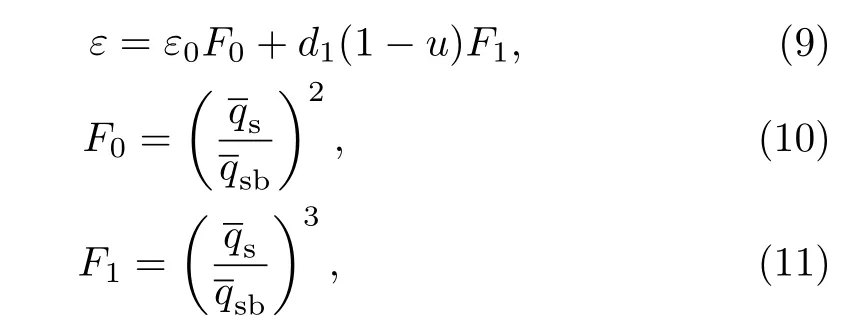
where ε0is the turbulent entrainment rate,which is equivalent to ε in Eq.(6);d1is truncation coefficient,with its magnitude around 10-4;qsand qsbare the saturated mixing ratio at each cloud level and at the cloud base,respectively;u is relatively humidity;and F0and F1are dimensionless variables.
To avoid unrealistically stronger convection,an arbitrary limitation of maximum mass flux(Mbmax= 0.1 kg m-2s-1)is imposed at the cloud base of the original scheme.Note that this limitation is not appropriate for global models under current resolution(50 km).For this reason,it is adjusted to depend on the vertical resolution and time step,and the Courant Friedrichs Lewy criterion(CFL)is used to determine it as:

where mbmaxis the maximum mass flux at the cloud base,Δp is the pressure depth of model level of cloud base,and Δt is time step.With this definition,the arbitrary value in the old scheme is removed and strong convection is allowed. Furthermore,it is also correlated with vertical resolution and time step of the model,making it a more reasonable option.
The level of cloud top in the original scheme is defined as the level of neutral buoyancy.However,neutral buoyancy condition only indicates that acceleration is zero at this level whereas convective overshooting still exists.In this study,the height of overshooting is identified above the neutral buoyancy level where the upward parcel lifted from the neutral buoyancy level costs 10%of CAPE.
2.2 Boundary layer diffusion
The boundary layer scheme is also revised in this study since it is highly correlated with shallow conve-ction scheme.One major purpose of this study is to improve the stratocumulus cloud simulation in the eastern Pacific.Stratocumulus clouds develop under combined effects of shallow convection and boundary layer diffusion.In order to better simulate stratocumulus clouds,it is necessary to improve not only shallow convection scheme but also vertical PBL diffusion scheme.
The current boundary layer scheme used in the global GRAPES is MRF boundary layer diffusion scheme(Troen and Mahrt,1986;Hong and Pan,1996),which is a K-closure nonlocal PBL scheme.In the present study,the cloud-top-driven vertical diffusion is added to the new boundary layer diffusion scheme based on the scheme proposed by Lock et al.(2000)for the coupling between the PBL and the stratocumulus clouds.The turbulent fluxes of boundary layer satisfy the following equation:


where κ is Von Kalman constant(κ=0.4);hbis the cloud top of stratocumulus;zbis the stratocumulus cloud base,which is the first level where the cloudtop-driven eddy diffusion should be calculated;and VScis the vertical velocity caused by entrainment at the cloud top,which is defined by

where Vradand Vbrare vertical velocities due to radiative cooling and buoyancy,respectively,and Vbris negligible in the study.Variable Vradis defined by

where ΔR is the radiative net flux from cloud base to cloud top;cpis specific heat at constant pressure level. The cloud-top entrainment flux is given by

where c is a constant set to 0.2 based on Moeng et al.(1999).In addition,the cloud-top entrainment instability(CTEI)must satisfy the following condition(Deardorff,1980;Randall,1980)

where Δθeand Δqtare changes in the equivalent potential temperature and total water content from the cloud starting level across to the cloud top,and c1is constant,which equals 0.7(MacVean and Mason,1990).


where Km/h(Ri)is momentum/heat turbulent diffusivity;Riis Richardson number;l is mixing length; s the absolute value of the vertical wind shear; and fm/h(Ri)is the stability function of momentum/heat,which is highly dependent on Richardson number.Variable fh(Ri)is modified under the stable condition and expressed as

while for unstable condition,they are defined as

Background turbulent diffusivity is also modified,but their impact is negligible,so we will not introduce details here.
3.Evaluation of the new convection and PBL schemes
The governing equations of the GRAPES global forecast system are the fully compressible,nonhydrostatic equations describing the complete dynamics of the atmosphere.A hydrostatic reference state of atmosphere is applied.It adopts a semi-implicit and semi-Lagrangian time integration scheme.The spatial discretization uses horizontally staggered Arakawa-C grid and the vertical coordinate is terrain-following with Charney-Philips vertical variation configuration(Chen et al.,2008;Xue and Chen,2008).The horizontal resolution of GRAPES is 50 km and there are 60 levels in the vertical,with the model top at around 36 km.Important physical schemes used in the GRAPES include the RRTMG longwave and shortwave radiation scheme(Mlawer et al.,1997),SAS cumulus parameterization,MRF PBL scheme,WSM6 microphysics scheme(Hong and Lim,2006),gravity wave drag scheme(Kim and Arakawa,1995;Lott and Miller 1997),and CoLM land surface scheme(Dai et al.,2003).
3.1 Evaluation of the new convection scheme
Considering the close relation between cumulus convection and PBL physics,both the convection scheme and the boundary layer diffusion scheme have been modified.The impact of the modifications in each scheme is considered separately in order to identify their unique impact.
Simulation of the total convective heating rate becomes more realistic with the modified cumulus scheme except for an abrupt low bias at around 800 hPa(Fig.3).A weak cooling tendency is found nearthe surface,which may be attributed to rainfall evaporation in shallow convection.Note that there are no constraints for precipitation imposed in the modified shallow convection scheme.This is based on the fact that shallow convection does induce drizzle sometimes in the real world.However,shallow convectioninduced precipitation is very small in the GRAPES(less than 2 mm;figure omitted).The total convective heating rate is larger in the modified scheme than in the old scheme,and the location of maximum heating rate shifts from 450-700 to 350-650 hPa.The level of maximum apparent heat source(Q1)from the modified scheme is more consistent with that proposed by Yanai et al.(1973).
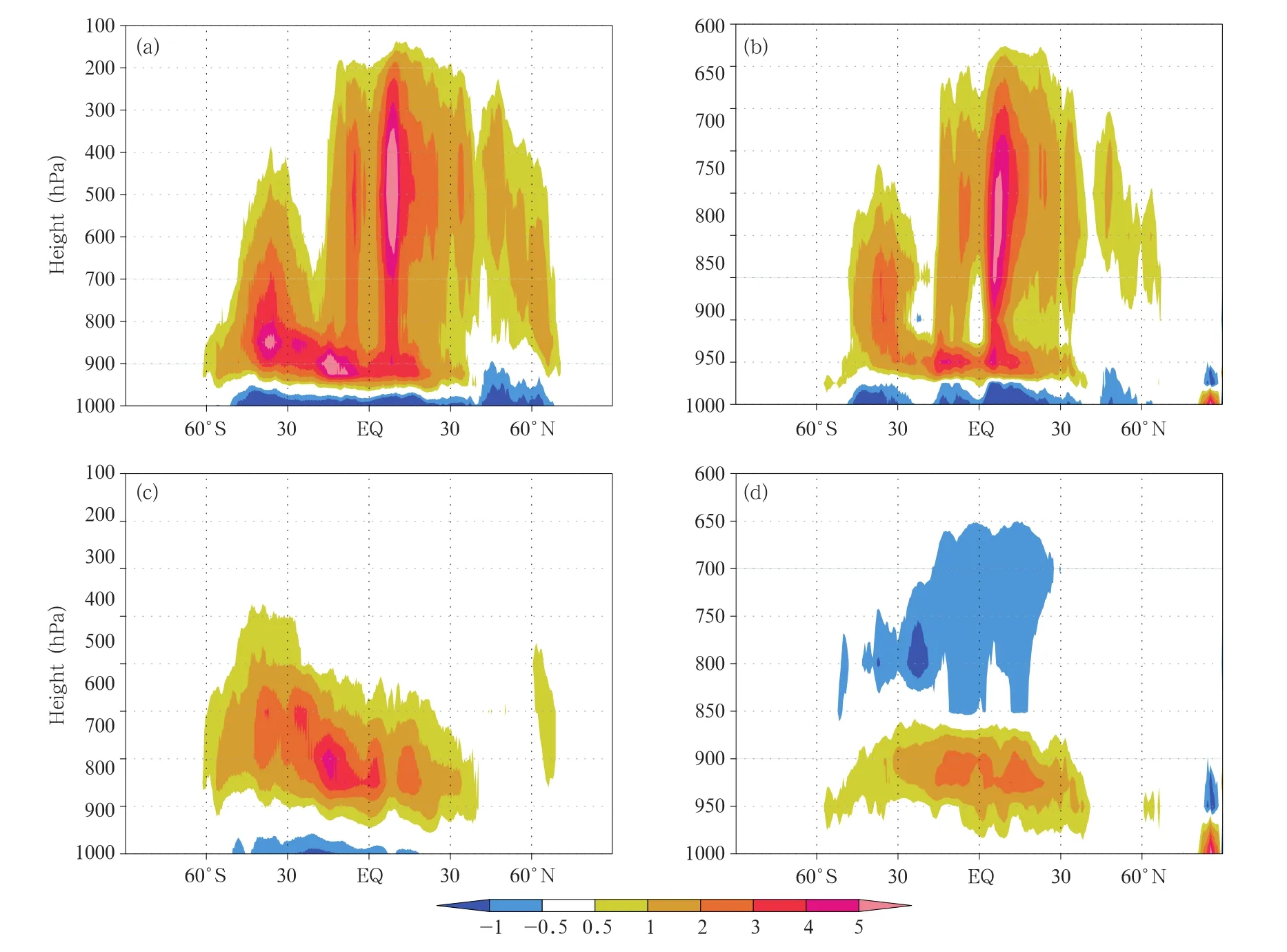
Fig.3.Zonal mean of the(a,b)total and(c,d)shallow convective heating rate(K day-1)simulated by the GRAPES global model using(a,c)the revised schemes and(b,d)the original schemes.
The simulated vertical heating profile at some single points shows similar improvement.In order to ensure that the simulations with the modified and the original cumulus schemes are carried out under similar environmental conditions,the vertical profiles of convective heating rate at all model points are extracted from the 24-h forecast outputs.The results at the point(2°S,100°W),which is to the east of the ITCZ,indicate that with the original scheme,shallow convective heating largely occurs at lower levels(950 hPa)while a cooling close to 3 K day-1occurs at 900 hPa. However,with the modified scheme,shallow convective heating becomes dominant and the largest heating occurs at around 925 hPa,a little higher than that for the original scheme.At the SPCZ point(2°S,120°E),shallow convective heating mainly occurs at around 1000 hPa with the original scheme,and a cooling center of about 0.5 K day-1occurs at 700 hPa.This is apparently not realistic.With the modified scheme,shallow convective warming occurs at almost all the levels except those close to the ocean surface,and the convective warming center lifts from the previous 1000 hPa to around 925 hPa(Fig.4b).These results indicate that the revised cumulus scheme can improve the model simulation and produce more reasonable results.
3.2 Necessity to improve the boundary layer diffusion scheme
One focus of the present study is to improve the shallow convection scheme.Does this imply any necessity for the improvement of the PBL scheme?Figure 5c is the same as Fig.2a,except that it shows the monthly mean total cloud fraction simulated by GRAPES with the revised cumulus scheme.Comparing Fig.5c with Fig.2a,Fig.5c shows clearly that total cumulus clouds simulated over the eastern Pacific have increased and stratocumulus clouds now cover a larger area.Meanwhile,total clouds over the ITCZ,which are often associated with deep convection,also increase in Fig.5c,probably due to intensified detrainment of high clouds generated by strengthened deep convection.The results in Fig.5c are more consistent with MODIS observations,compared with Fig. 2a,suggesting that the revised cumulus scheme has improved the simulation of both shallow and deep convection.However,a maximum cloud cover area parallel to the ITCZ appears over the tropical southern Pacific in Fig.5c,indicating errors in simulation of a“double ITCZ”.When both the revised cumulus and PBL schemes are applied,the“double ITCZ”error is effectively removed(Fig.5a).Large amounts of clouds with cloud cover fraction higher than 90%appear over the coastal region of Peru in the eastern Pacific and South America,which agrees better to MODIS observations.
Further analysis indicates that without the revised PBL scheme,turbulent mixing and diffusion at the top of the stratocumulus clouds is not considered,which directly leads to overestimation of stratocumulus clouds.The“double ITCZ”error in the simulation can further affect the simulation of the entire tropical circulation system.Hence,it is not sufficient to solely revise the cumulus scheme in the GRAPES.With modification of both the cumulus and PBL schemes,the“double ITCZ”error is overcome while the high cloud simulation over the ITCZ improves and is more consistent with MODIS observation.Therefore,it is necessary to consider the coupling between the PBL processes and stratocumulus clouds.
To diagnose the vertical properties of stratocumulus clouds,a vertical cross-section of cloud-water mixing ratio along 5°S is shown in Fig.6.During the boreal autumn,stratocumulus clouds appear relativelylow due to the low inversion layer over the eastern Pacific(Yang et al.,2010).In the present study,we identify the height of cumulus clouds according to cloud top pressure.MODIS observations indicate that the cloud tops are below 800 hPa around 5°S to the east of 90°W.Between 140°and 120°W,the top of stratocumulus clouds is even below 900 hPa.With the original cumulus and PBL schemes,the simulated top of stratocumulus clouds is almost always above 800 hPa.In the regions to the west of 120°W,cloud water mixing ratio is underestimated whereas the simulated cloud top is around 700-800 hPa.The above errors in the simulation are attributed to unrealistically strong vertical transport of cloud water,which is caused by overestimation of shallow convection in the model simulation.Such an overestimation in shallow convection and vertical transport of cloud water completely violates the coupling relations between the PBL processes and cumulus convective activities.With the revised PBL and cumulus schemes,the simulated height of stratocumulus clouds is basically below 800 hPa,and the monthly average height of stratocumulus cloudsover 120°-140°W is around 850 hPa.The base of the simulated stratocumulus clouds is largely below 925 hPa with the old schemes,whereas it is located around 950 hPa with the revised schemes.Apparently,the revised schemes produce a more realistic simulation compared with the original schemes. In addition,in the simulation with the revised schemes,the maximum cloud water mixing ratio occurs over 80°-85°W,corresponding to the cold offshore current area over the ocean.Figure 5d shows clearly a maximum center over this region,while in the simulation with the old schemes,this centercompletely disappears.In general,the vertical properties of stratocumulus clouds are more reasonably simulated with the revised schemes and more consistent with observations.
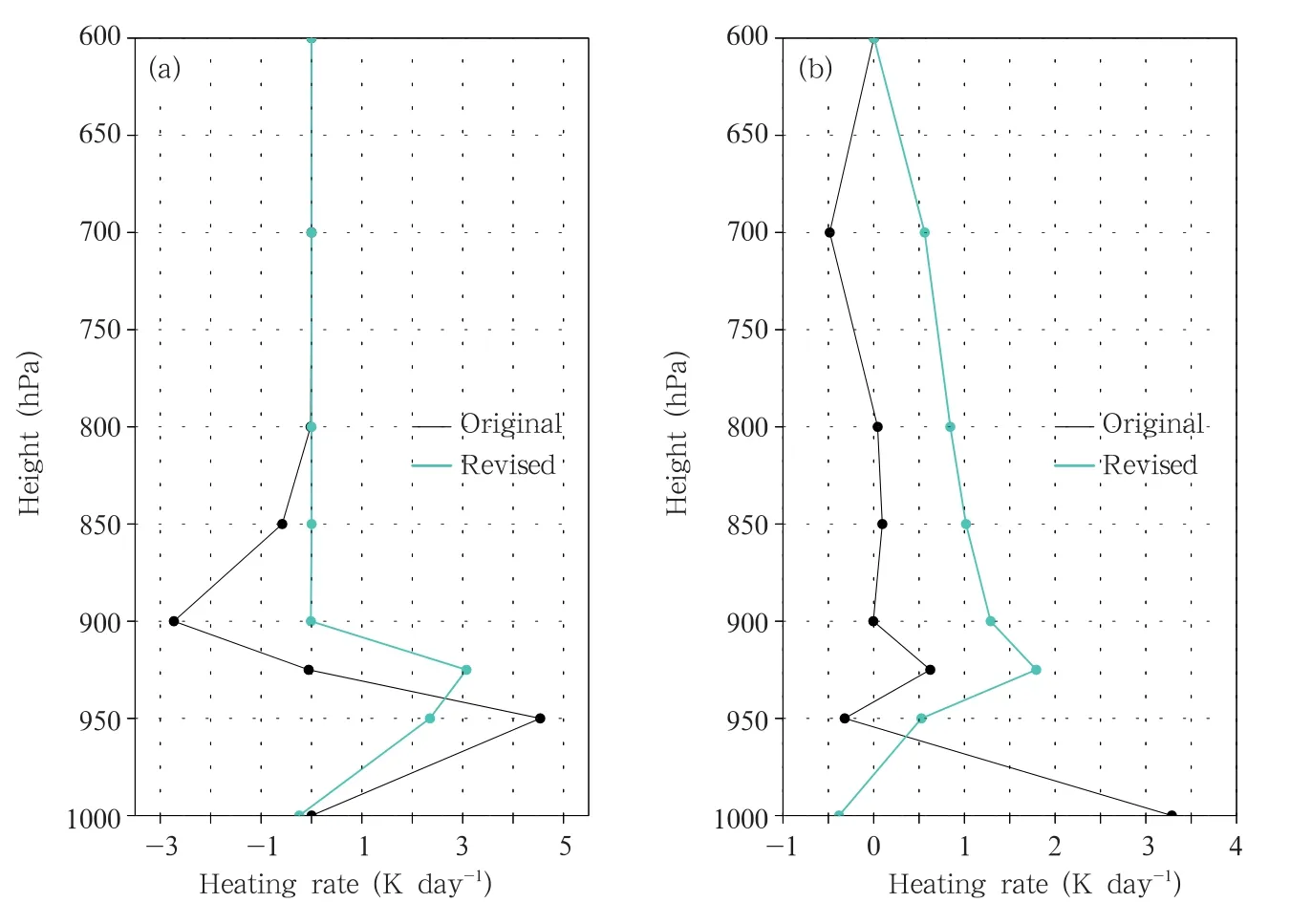
Fig.4.The vertical convective heating rate profile(K day-1)at(a)2°S,100°W and(b)5°S,120°E simulated with the revised cumulus scheme(green line)and original cumulus scheme(black line),respectively.
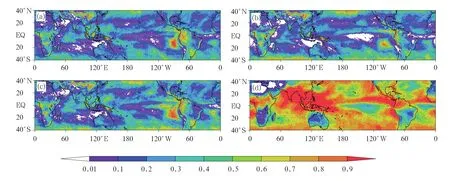
Fig.5.Monthly mean total cloud cover fraction from simulations and MODIS observations.(a)Simulation with the modified PBL and cumulus schemes,(b)simulation with the original schemes,(c)simulation with the modified convection scheme only,and(d)MODIS observations.
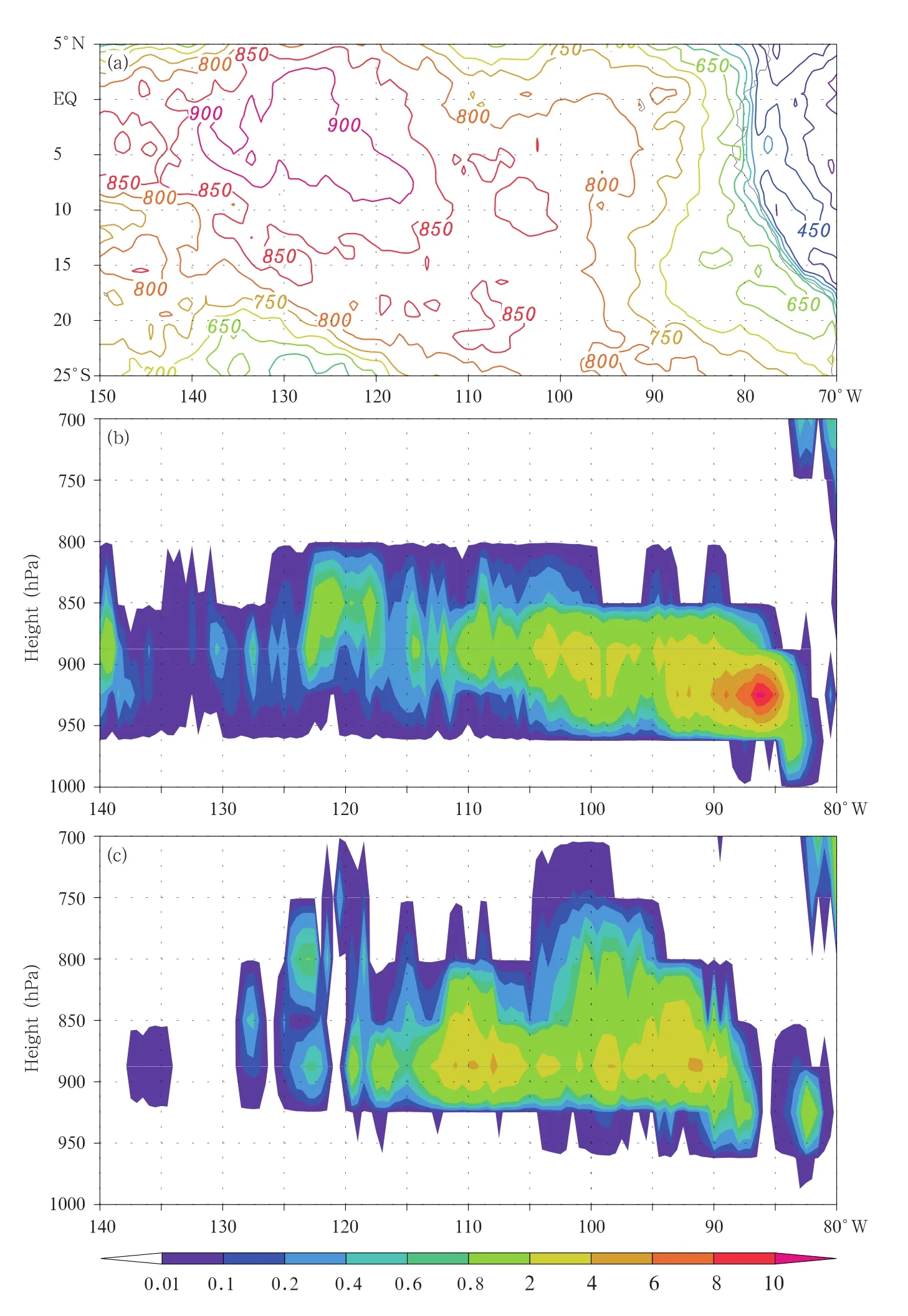
Fig.6.(a)Monthly mean cloud top pressure(hPa)for October 2012 from MODIS data,(b)vertical cross-section of simulated cloud water mixing ratio with the revised cumulus and PBL schemes along 5°S,and(c)the same as(b)but with the original schemes.
3.3 Evaluation of the GRAPES global model performance with the modifiedPBLand cumulus schemes
In Section 3.2,we have evaluated simulations of convective heating rate and stratocumulus cloud properties over the eastern Pacific,which is a region of large amounts of stratocumulus clouds.Impacts of the revised schemes have been illustrated.In this section,we will further investigate how the revised cumulus and PBL schemes affect simulations of global precipitation and large-scale circulation.The capability of the global GRAPES will also be assessed.
Modification of cumulus and PBL schemes is a focus of the present study,and their impacts on the GRAPES model performance will be evaluated based on the GRAPES simulations over the tropical region of the Northern Hemisphere during summertime.All experiments are conducted for July 2013.The GRAPES is initialized on a daily basis by using the FNL analysis and runs for 8 days.The monthly average results are used for further analysis.
We are concerned about the precipitation simulation over the tropical region since it directly reflects the impact of the revised schemes.Figure 7 shows the precipitation simulation with the original and the revised scheme as well as the observation from the Tropical Rainfall Measuring Mission(TRMM).With the revised schemes,the spurious precipitation over the Indian Peninsula and the Bay of Bengal is effectively suppressed.Precipitation simulation is also improved over the warm pool region,where the precipitation underestimation is severe with the original schemes.Compared with the original schemes,the revised schemes can produce precipitation simulation that is more consistent with the TRMM observation(Kummerow et al.,1998).
Figure 8 presents time evolution of the summertime western Pacific subtropical high,including its westward extension and northward movement.The results are compared with the FNL analysis.In general,the simulated subtropical high becomes stronger with the revised schemes than with the original schemes,particularly in its westward extension.During 17-25 July 2013,the simulated 5880-gpm contour extends to nearby 120°E with the revised schemes,whereas it is not clear at all with the original schemes.However,the subtropical high intensity is still underestimated in the GRAPES simulation even with the revised schemes,indicating that further analysis should be done to explore the reasons behind such an underestimation.It is probably due to inconsistencies between physical schemes and/or problems in the coupling between the model dynamics and physics.
The GRAPES evaluation tools(GET),which is a system used to verify the operational GRAPES,is employed to evaluate results of batch tests of GRAPES in the present study and to obtain objective assessment of the revised schemes.Figure 9a shows the correlation coefficient of 500-hPa geopotential height anomalies between GRAPES simulation and FNL analysis for July 2013.This month is taken as a typical summer month in the Northern Hemisphere.The red boxes in Figs.9a and 9b indicate the range of 95%confidence level.The red lines represent results with the revised cumulus and PBL schemes,and the black lines for control run with the original schemes.Figure 9a shows that the correlation coefficient of 500-hPa geopotential height anomalies becomes significantly large after the 4th day of forecast and remains large until the 8th day of forecast.This indicates that with the revised cumulus and PBL schemes,the GRAPES forecast is valid for 7 days in advance.In addition,the root mean square errors(RMSEs)of wind fields in the tropics with the revised schemes and the original schemes also indicate that the revised schemes can improve simulation of winds,and the improvements are statistically significant.The RMSEs of winds can be reduced by approximately 1 m s-1.
Statistical analysis(figure omitted)indicates that with the revised schemes,the simulation of geopotential height and wind fields are improved over the Northern Hemisphere and the tropical region,and the improvements are statistically significant.
4.Conclusions and discussion
The cumulus and PBL schemes are two important physical schemes in numerical modeling study.They play a key role in maintaining the heat,moisture,and momentum fluxes in the earth system.The heating of the atmosphere caused by latent heat release during the cumulus convection and the radiative cooling of stratocumulus clouds over the eastern Pacific are two important processes in numerical weather forecast.In the original GRAPES,a turbulent mixing and diffusion method is used to describe shallow convection. This method overestimates shallow convection in the PBL and produces unreasonable convective heating rate in the vertical.In this study,both the shallow convection and PBL schemes are modified to realistically simulate related physical processes in the atmosphere.Batch experiments have been conducted by using both the revised and the original schemes. Diagnostic analyses of the results from these experiments indicate that the modified cumulus and PBL schemes have significantly improved the performance of the global GRAPES.Major results are as follows.
(1)The original shallow convection scheme in theglobal GRAPES generates unrealistic cooling at the top of the shallow convection.As a result,the total convective heating rate becomes unrealistically small at the top of shallow convection.Meanwhile,stratocumulus clouds in the coastal region of Peru in eastern Pacific are underestimated while the cloud top is abnormally higher than observation.
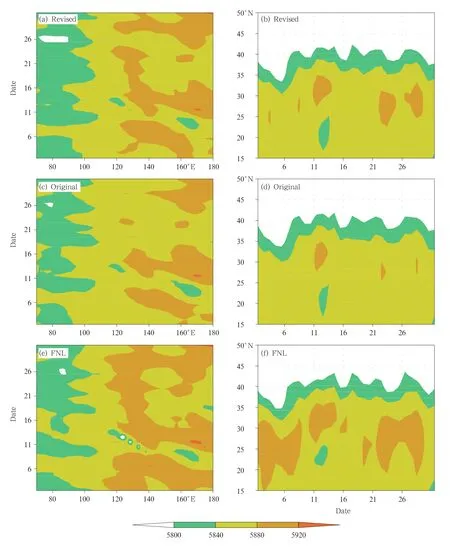
Fig.8.Evolution of the western Pacific subtropical high in July 2013.(a,c,e)Time-longitude cross-sections of the WPSH simulated with the revised and the original schemes respectively and from FNL analysis,and(b,d,f)time-latitude cross-sections of the WPSH simulated with the revised and the original schemes and from FNL.
(2)In the present study,a mass flux method is applied in the shallow convection scheme to replace the original method that is based on turbulent diffusion.The closure assumption for shallow convection considers the surface properties,and deep convection is also adjusted to become more reasonable.This change ensures that deep and shallow convection schemes are consistent with each other. The coupling between the PBL processes and stratocumulus clouds,i.e.,the CTEI effect,is also well considered in the present study.Under the condition of stable stratification that is favorable for the formation of stratocumulus clouds,the stability function is adjusted and becomes more realistic.

Fig.9.(a)500-hPa geopotential height anomaly correlation coefficient in the Northern Hemisphere and(b)root mean square error(RMSE)of winds at 850 hPa over the tropics.Red lines represent results from the revised schemes and black lines from the original schemes.
(3)With only modification of convection scheme,the simulation of convective heating rate becomes more reasonable but the stratocumulus clouds over the eastern Pacific are overestimated and cover an unrealistically large area.Hence,it is necessary to modify the PBL scheme simultaneously.With modification of both the cumulus and PBL schemes,stratocumulus clouds are well simulated and the vertical structure of the stratocumulus clouds is consistent with observations.
(4)With the modified cumulus and PBL schemes,spurious precipitation over the tropics is suppressed and the underestimation of precipitation over the warm pool region is improved.These modifications also increase the 500-hPa geopotential height anomaly correlation coefficient and effectively extend the valid forecast period.Circulations at the tropics are also improved with the revised schemes.The statistical scorecard indicates that the performance of the global GRAPES with the revised schemes has been significantly improved. The simulations of geopotential height and wind fields are improved over the Northern Hemisphere and the tropical region.These results demonstrate that the modification of cumulus and PBL schemes in the present study could contribute to the development and improvement of the global GRAPES.
Acknowledgments.The authors would like to express their gratitude to Drs.Pan Hua-lu and Shen Xueshun for helpful discussion and comments.We are also grateful to Dr.Zhao Bin for supporting us in running the GET evaluation system.
Acker,J.G.,and G.Leptoukh,2007:Online analysis enhances use of NASA earth science data.Eos.Trans. Amer.Geophys.Union,88,14-17.
Arakawa,A.,and W.H.Schubert,1974:Interaction of a cumulus cloud ensemble with the large-scale environment,Part I.J.Atmos.Sci.,31,674-701.
Bechtold,P.,M.K¨ohler,T.Jung,et al.,2008:Advances in simulating atmospheric variability with the ECMWF model:From synoptic to decadal timescales.Quart.J.Roy.Meteor.Soc.,134,1337-1351.
ChenDehui,XueJishan,YangXuesheng,etal.,2008:New generation of multi-scale NWP system(GRAPES):General scientific design.Chin.Sci. Bull.,53,3433-3445.
Dai,Y.J.,X.B.Zeng,R.E.Dickinson,et al.,2003:The common land model.Bull.Amer.Meteor.Soc.,84,1013-1023.
Deardorff,J.W.,1980:Cloud top entrainment instability.J.Atmos.Sci.,37,131-147.
Deng Hua,Xue Jishan,Xu Haiming,et al.,2008:Study of different cumulus parameterization schemes of GRAPES-Meso model in simulation of convection provocation.J.Trop.Meteor.,24,327-334.(in Chinese)
Grant,A.L.,and A.R.Brown,1999:A similarity hypothesis for shallow-cumulus transports.Quart.J. Roy.Meteor.Soc.,125,1913-1936.
Grant,A.L.M.,2001:Cloud-base fluxes in the cumuluscapped boundary layer.Quart.J.Roy.Meteor. Soc.,127,407-421.
Han,J.,and H.L.Pan,2011:Revision of convection and vertical diffusion schemes in the NCEP global forecast system.Wea.Forecasting,26,520-533.
Hong,S.Y.,and H.L.Pan,1996:Nonlocal boundary layer vertical diffusion in a medium-range forecast model.Mon.Wea.Rev.,124,2322-2339.
Hong,S.-Y.,and J.-O.J.Lim,2006:The WRF singlemoment 6-class microphysics scheme(WSM6).J. Korean Meteor.Soc.,42,129-151.
Kain,J.S.,and J.M.Fritsh,1990:A one-dimensional entraining/detraining plume model and its application in convective parameterization.J.Atmos.Sci.,47,2784-2802.
Kim,Y.-J.,and A.Arakawa,1995:Improvement of orographic gravity wave parameterization using a mesoscale gravity-wave model.J.Atmos.Sci.,52,1875-1902.
Kummerow,C.,W.Barnes,T.Kozu,et al.,1998:The tropical rainfall measuring mission(TRMM)sensor package.J.Atmos.Ocean.Technol.,15,809-817.
Li Lijuan and Wang Bin,2010:Influence of two different convection schemes on the radiative energy budget in GAMIL1.0.Acta Meteor.Sinica,24,318-327.
Liu Kun,Liu Yimin,and Wu Guoxiong,2010:The impacts of the modified Tiedtke cumulus convective parameterization scheme on the tropical rainfall simulation in SAMIL model. Chinese J.Atmos. Sci.,34,163-174.(in Chinese)
Liu Yiming and Ding Yihui,2002:Modified mass flux cumulus convective parameterization scheme and its simulation experiment.Part I:Mass flux scheme and its simulation of the 1991 flood event. Acta Meteor.Sinica,16,37-49.
Lock,A.P.,A.R.Brown,M.R.Bush,et al.,2000:A new boundary layer mixing scheme.Part I:Scheme description and single-column model tests. Mon. Wea.Rev.,128,3187-3199.
Lott,F.,and M.J.Miller,1997:A new subgrid-scale orographic drag parameterization:Its formulation and testing.Quart.J.Roy.Meteor.Soc.,123,101-127. MacVean,M.K.,and P.J.Mason,1990:Cloud-top entrainment instability through small-scale mixing and its parameterization in numerical models.J. Atmos.Sci.,47,1012-1030.
Mlawer,E.J.,S.J.Taubman,P.D.Brown,et al.,1997:Radiative transfer for inhomogeneous atmospheres:RRTM,a validated correlated-k model for the longwave.J.Geophys.Res.,102,16663-16682.
Moeng,C.H.,P.P.Sunllivan,and B.Stevens,1999:Including radiative effects in an entrainment rate formula for buoyancy-driven PBLs.J.Atmos.Sci.,56,1031-1049.
Nie,J.,and Z.M.Kuang,2012:Responses of shallow cumulus convection to large-scale temperature and moisture perturbations:A comparison of large-eddy simulations and a convective parameterization based on stochastically entraining parcels.J.Atmos.Sci.,69,1936-1956.
Pan,H.-L.,and W.-S.Wu,1995:Implementing a Mass Flux Convective Parameterization Package for the NMC Medium-Range Forecast Model.NMC Office Note 409,Washington,DC,1-40.
Raga,G.B.,J.B.Jensen,and M.B.Baker,1990:Characteristics of cumulus band clouds off the coast of Hawaii.J.Atmos.Sci.,47,338-356.
Randall,D.A.,1980:Conditional instability of the first kind upside-down.J.Atmos.Sci.,37,125-130.
Siebesma,A.P.,and J.W.M.Cuijpers,1995:Evaluation of parametric assumptions for shallow cumulus convection.J.Atmos.Sci.,52,650-666.
Siebesma,A.P.,C.S.Bretherton,A.Brown,et al.,2003:A large eddy simulation intercomparison study of shallow cumulus convection.J.Atmos.Sci.,60,1201-1219.
Siebesma,A.P.,P.M.M.Soares,and J.Teixeira,2007:A combined eddy-diffusivity mass flux approach for the convective boundary layer.J.Atmos.Sci.,64,1230-1248.
Tiedtke,M.,1989:A comprehensive mass flux scheme for cumulus parameterization in large-scale models. Mon.Wea.Rev.,117,1779-1800.
Tiedtke,M.,W.A.Heckley,and J.Slingo,1988:Tropical forecasting at ECMWF:The influence of physical parametrization on the mean structure of forecasts and analyses.Quart.J.Roy.Meteor.Soc.,114,639-664.
Troen,I.,and L.Mahrt,1986:A simple model of the atmospheric boundary layer:Sensitivity to surface evaporation.Bound.-Layer Meteor.,37,129-148.
von Salzen,K.,N.A.McFarlane,and M.Lazare,2005: The role of shallow convection in the water and energy cycles of the atmosphere.Climate Dyn.,25,671-688.
Xu Daosheng,Chen Zitong,Dai Guangfeng,et al.,2014:The influence of an improved cumulus parameterization scheme on typhoon forecast from GRAPES model.J.Trop.Meteor.,30,210-218.(in Chinese)
Xue Jishan and Chen Dehui,2008:Scientific Design and Application of Numerical Prediction System GRAPES.Science Press,Beijing,334-335.(in Chinese)
Yanai,M.,S.Esbensen,and J.-H.Chu,1973:Determination of bulk properties of tropical cloud clusters from large-scale heat and moisture budgets.J.Atmos.Sci.,30,611-627.
Yang,F.L.,H.L.Pan,S.K.Krueger,et al.,2010:Evaluation of the NCEP Global Forecast System at the ARM SGP site.Mon.Wea.Rev.,134,3668-3690.
Zhang,G.J.,and N.A.McFarlane,1995:Sensitivity of climate simulations to the parameterization of cumulus convection in the Canadian Climate Centre general circulation model.Atmos.-Ocean,33,407-446.
Liu Kun,Chen Qiying,and Sun Jian,2015:Modification of cumulus convection and planetary boundary layer schemes in the GRAPES global model.J.Meteor.Res.,29(5),806-822,
10.1007/s13351-015-5043-5.
(Received May 10,2015;in final form August 16,2015)
 Journal of Meteorological Research2015年5期
Journal of Meteorological Research2015年5期
- Journal of Meteorological Research的其它文章
- Interannual Variability of the Wintertime Northern Branch High Ridge in the Subtropical Westerlies and Its Relationship with Winter Climate in China
- Analysis of Tibetan Plateau Vortex Activities Using ERA-Interim Data for the Period 1979-2013
- A Piecewise Modeling Approach for Climate Sensitivity Studies:Tests with a Shallow-Water Model
- Characteristics and Mechanisms of the Sudden Warming Events in the Nocturnal Atmospheric Boundary Layer:A Case Study Using WRF
- A New Evaporation Duct Climatology over the South China Sea
- Cloud Radiative Forcing Induced by Layered Clouds and Associated Impact on the Atmospheric Heating Rate
